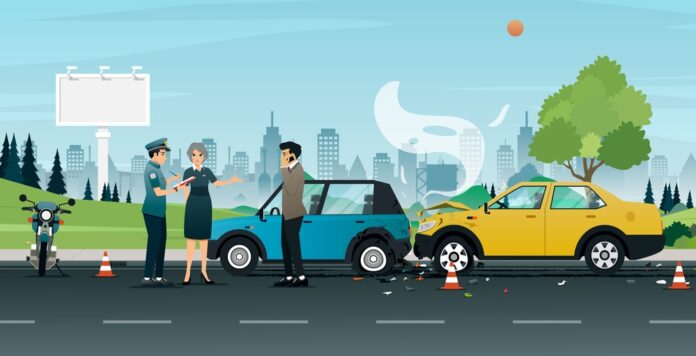Car accidents are not just a personal risk—they’re a business liability when they occur during work-related tasks. For businesses that rely on employees to drive for their roles, understanding how workers’ compensation applies to car accidents is essential for managing financial and legal risks. This guide explains how workers’ compensation works for car accidents, what it covers, and how businesses can navigate the claims process effectively.
When Does Workers’ Compensation Cover Car Accidents?
Workers’ compensation insurance generally covers injuries that employees sustain while performing work-related duties, including car accidents. However, the circumstances of the accident determine whether it qualifies for coverage.
Covered Situations
Workers’ comp typically applies if an employee is injured in a car accident while:
- Driving as part of their job responsibilities (e.g., delivery drivers, sales representatives).
- Running errands or tasks assigned by their employer.
- Traveling between job sites during working hours.
- Attending off-site meetings or training sessions required by their employer.
Excluded Situations
Not all driving-related accidents qualify for workers’ comp. Common exclusions include:
- Commuting to or from work: Standard commutes are not considered work-related unless an exception applies (e.g., running a work errand en route).
- Personal errands: If the employee was using a company vehicle or work hours for personal tasks, the accident may not be covered.
- Violations of company policy: Workers’ comp may not apply if the accident occurred while the employee was engaging in reckless behavior or violating company driving policies.
What Does Workers’ Compensation Cover?
Legal experts handling car accidents explain that when an employee qualifies for workers’ compensation due to an accident, they may receive several types of benefits:
1. Medical Expenses
Workers’ compensation covers medical costs related to the injury, including:
- Emergency care and hospitalization.
- Doctor visits, diagnostic tests, and treatment plans.
- Rehabilitation and physical therapy.
- Prescription medications and medical equipment.
2. Wage Replacement
If the employee cannot work due to their injuries, workers’ comp provides partial wage replacement. This is typically a percentage of their average weekly earnings, capped at a state-specific maximum.
3. Permanent Disability Benefits
For injuries that result in long-term or permanent disability, workers’ compensation may provide additional payments to compensate for lost earning capacity.
4. Death Benefits
In the unfortunate event of a fatal accident, workers’ compensation can provide death benefits to the employee’s dependents, covering funeral expenses and a portion of lost income.
The Role of Third-Party Liability
In some cases, another party’s negligence may have caused the accident. While workers’ compensation is a no-fault system—meaning benefits are provided regardless of who caused the accident—employees may also have the option to file a third-party liability claim against the at-fault driver.
If the employee recovers damages from the at-fault party through a lawsuit or settlement, the employer’s workers’ comp insurer may seek reimbursement for benefits already paid. This process, called subrogation, helps prevent double recovery.
Steps for Employers to Manage a Workers’ Compensation Claim
For businesses, navigating a workers’ comp claim following a car accident requires careful attention to detail and adherence to state regulations. Here are key steps to take:
- Ensure Employee Safety: Immediately after the accident, prioritize the employee’s health and safety. Encourage them to seek medical care promptly, even for seemingly minor injuries, to prevent complications and document their condition.
- Report the Incident: Employees should notify their employer of the accident as soon as possible. Employers, in turn, must report the claim to their workers’ compensation insurance carrier and comply with any state-specific reporting deadlines.
- Document the Accident: Collect as much information about the accident as possible, including: police reports, witness statements, photos of the scene and vehicle damage. This documentation can help the insurance provider assess the validity of the claim.
- Work with the Insurer: Cooperate fully with your workers’ compensation carrier during the investigation. Provide all requested documentation and facilitate communication between the insurer and the injured employee.
- Create a Return-to-Work Plan: For employees recovering from injuries, businesses should develop a plan to facilitate their return to work. This might include offering modified duties or flexible hours to accommodate their recovery.
How Can Businesses Reduce Risk?
Preventing accidents and minimizing workers’ comp claims is critical for controlling costs and protecting employees. Businesses can take several proactive measures to reduce risks:
1. Implement a Driver Safety Program
Establish clear policies on safe driving practices, including:
- Adhering to speed limits and traffic laws.
- Prohibiting phone use while driving.
- Mandating seatbelt use.
- Regular training sessions can reinforce these policies and keep safety top of mind.
2. Conduct Vehicle Inspections
Ensure company-owned vehicles are well-maintained by scheduling regular inspections and addressing issues promptly.
3. Screen Drivers Carefully
For roles involving driving, conduct thorough background checks to verify that employees have valid licenses and clean driving records.
4. Review Insurance Coverage
Work with your insurance provider to ensure your workers’ comp policy and commercial auto insurance provide adequate coverage for your operations.
The Financial Implications of Workers’ Compensation Claims
Car accident claims can have significant financial implications for businesses. High claim volumes can lead to increased workers’ compensation premiums, impacting the bottom line. By understanding how workers’ compensation works and implementing preventive measures, businesses can manage these risks effectively.
Workers’ compensation provides crucial support for employees injured in work-related car accidents, covering medical expenses, lost wages, and more. For businesses, understanding the coverage criteria and claims process is vital for protecting both employees and company finances.
By fostering a culture of safety and maintaining a clear claims process, businesses can reduce the likelihood of accidents and ensure compliance with workers’ compensation regulations. When accidents happen, acting promptly and responsibly can make all the difference in achieving a fair and efficient resolution.
Find a Home-Based Business to Start-Up >>> Hundreds of Business Listings.
















































